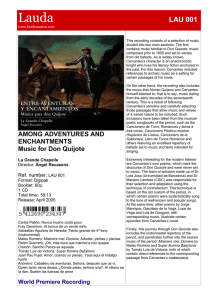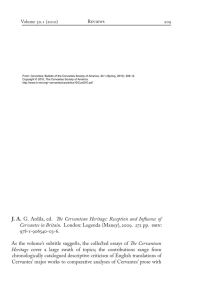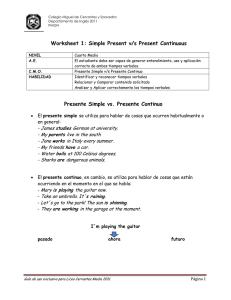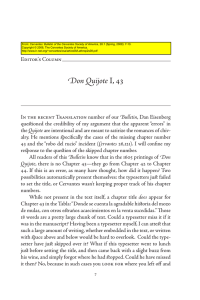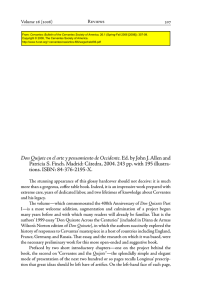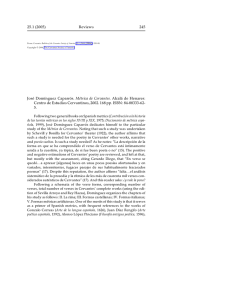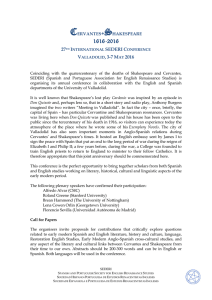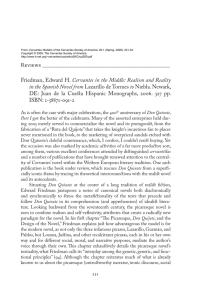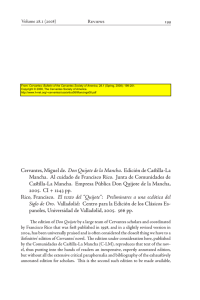La casa de los celos - H-Net
Anuncio
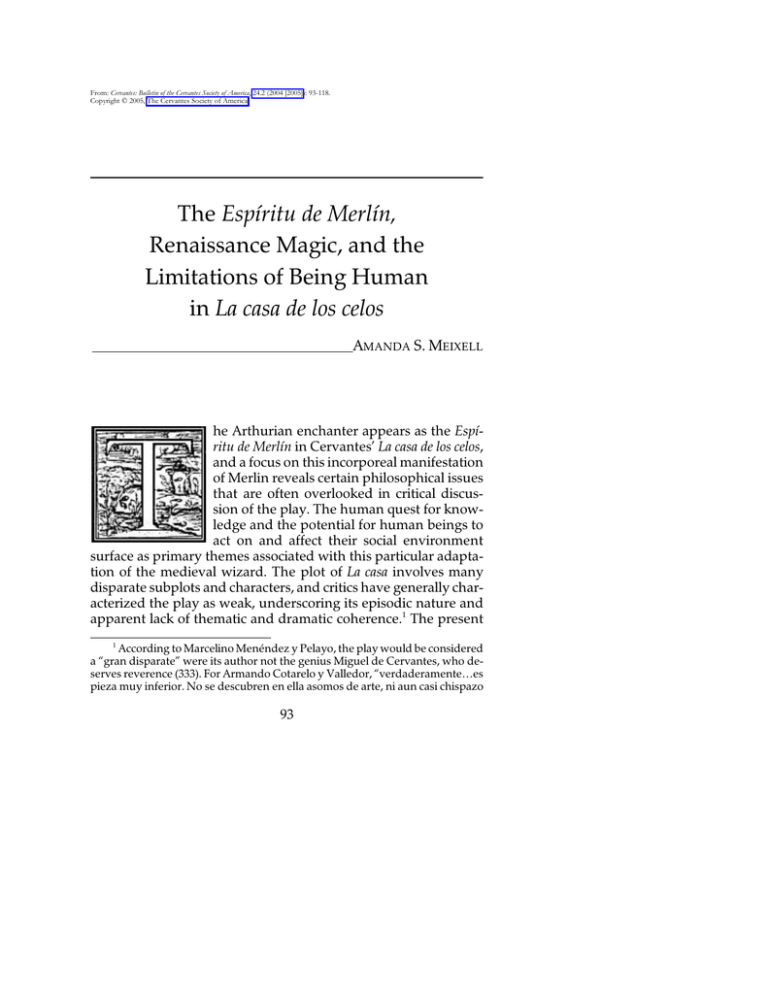
From: Cervantes: Bulletin of the Cervantes Society of America, 24.2 (2004 [2005]): 93-118. Copyright © 2005, The Cervantes Society of America. The Espíritu de Merlín, Renaissance Magic, and the Limitations of Being Human in La casa de los celos AMANDA S. MEIXELL he Arthurian enchanter appears as the Espíritu de Merlín in Cervantes’ La casa de los celos, and a focus on this incorporeal manifestation of Merlin reveals certain philosophical issues that are often overlooked in critical discussion of the play. The human quest for knowledge and the potential for human beings to act on and affect their social environment surface as primary themes associated with this particular adaptation of the medieval wizard. The plot of La casa involves many disparate subplots and characters, and critics have generally characterized the play as weak, underscoring its episodic nature and apparent lack of thematic and dramatic coherence.1 The present 1 According to Marcelino Menéndez y Pelayo, the play would be considered a “gran disparate” were its author not the genius Miguel de Cervantes, who deserves reverence (333). For Armando Cotarelo y Valledor, “verdaderamente…es pieza muy inferior. No se descubren en ella asomos de arte, ni aun casi chispazo 93 94 A MANDA S. M EIXELL Cervantes essay seeks to reveal how the role of the Espíritu de Merlín provides a lens through which we can interpret the various episodes of the main plot, revealing thematic unity among the seemingly unrelated elements. Merlin’s presentation as a spirit in La casa immediately recalls his status as defunct wizard. In the French Vulgate and Post-Vulgate cycles, the magician is ultimately interred at the hands of a woman. And the Spanish Baladro del sabio Merlín, largely based on the French Post-Vulgate, recounts an especially dark version of the wizard’s final entombment.2 He is buried alive, and from the grave he calls out in a demonic voice to his father to save him. Finally, he releases a loud death shriek heard throughout the land. Thus, the idea of Merlin’s continuing to make his presence known from the grave is not altogether new. But what is especially striking about the sage’s participation from the afterlife in this comedia is the play’s insistence on his active role as a spirit and its apparent incorporation of this being within the larger context of Renaissance magic.3 Cervantes comes alguno de bondad en la forma” (507), and even Schevill and Bonilla state that “el lector más benévolo reconocerá que Cervantes erró fundamentalmente al escoger por argumento de una obra dramática una serie de incidentes que nada tienen de teatral. Se suceden caprichosamente las escenas, sin justificación de cambio y sin criterio psicológico alguno” (6: 107). More recently, Paul Lewis-Smith has underscored the challenge that the play presents to critics seeking to reveal a unity of theme: “That Cervantes’ comedias do, at least, tend to be unified thematically was indicated by Joaquín Casalduero in his study of ‘sentido and forma’ in Cervantes’ theater and has since been confirmed by Edward H. Friedman in a stimulating review of the whole question of Cervantes’ approach to structure in the comedia. Of the plays that continue to be problematical the foremost is La casa de los celos…. Although it has certain motifs, like, for example, celos, La casa…is, as yet, far from revealing a definite thematic unity under rigorous critical inspection” (“Cervantes on Human Absurdity” 94–95). 2 In her dissertation, Barbara D. Miller details the textual ancestry of the fifteenth-century Baladro. For Miller, the Baladro is a uniquely Spanish Merlinian story, deeply rooted in the French thirteenth-century Post-Vulgate Suite du Merlin. 3 Cervantes based the dramatic action of the play on the Italian Renaissance epics Orlando innamorato by Matteo Maria Boiardo and Orlando furioso by Lodovico Ariosto. In both, a dead and yet relevant Merlin plays a minimal role within the narrative. In Boiardo’s text, the Arthurian enchanter is primarily referenced in connection with his water fountain that was designed to cure knights of irrational love. Cervantes does not employ this fountain as an important dramatic element 24.2 (2004) Magic and the Limits of Being Human 95 to use the absence of Merlin and his continuing powers to suggest the limits of human power, and he uses Merlin’s presence (embodied in the pillar that marks his grave) to serve as a unifying force that visually provides for the spectator a sense of continuity among the primary and secondary plots throughout the entire play. Instead of diminishing in stature and importance as his discarnate form would suggest, Merlin actually assumes the role of the ultimate Voice of Reason and figures in the comedia in two major ways. First, participating in the main plot, he interacts with the human magician Malgesí, the mortal sorcerer who dedicates himself to curing two crazed knights of their incapacitating and destructive passion. These two paladins, Roldán and Reinaldos, fall madly in love with Angélica upon her arrival at Charlemagne’s court in Act I, and the majority of the dramatic action is dedicated to Malgesí’s (unsuccessful) efforts to heal the demented suitors. Cervantes alters the relationship, established in earlier traditions, between the Arthurian enchanter and those seeking his wisdom. In French cyclical romance, for example, Merlin, overcome by his weakness for the ladies, does indeed teach his magical arts to two women, Morgan and Vivianne/Niviene.4 These females seek to learn the occult ways by which they can although he does make two passing references to it. In Ariosto’s chivalric romance Merlin is referred to as a spirit, the defunct yet vocal wizard. He functions primarily as a prophetic ghost instrumental in uniting the two young lovers (Bradamante and Ruggiero), who ultimately take center stage in Orlando furioso but whose story does not figure in La casa. Ariosto couples the Arthurian wizard with a female sorceress, Melissa, who serves as his magical assistant and lives in his cave. Cervantes makes no mention of this enchantress. In fact, the Golden Age Espíritu de Merlín little resembles his precursors in the Italian epics, and Cervantes’ unique treatment of him must be analyzed on its own terms. While in the Italian works Merlin is one of many prophets, sorcerers, and magicians who appear sporadically throughout the complex and long narrations, in La casa the Arthurian wizard’s disembodied voice, along with a human magician named Malgesí, occupies the foreground in questions relating to magic. 4 Barbara D. Miller discusses Merlin and his relationships with dangerous women in Chapters 3 and 4 of her dissertation. For more on this subject, see also Chapters 3 and 4 of Aileen MacDonald’s The Figure of Merlin in Thirteenth-Century French Romance and Chapters 4 and 5 of Carol E. Harding’s Merlin and Legendary Romance. 96 A MANDA S. M EIXELL Cervantes influence the wizard, diminish his powers, and thereby achieve objectives that are at odds with the sorcerer’s. In romance, Merlin’s tutelage in magic is inextricably linked to his problematic relations with women and to his ultimate demise. In Cervantes’ play, however, the Espíritu de Merlín emerges as a supernatural, superior being who is situated within a new set of circumstances, an extensive world of Renaissance magic, embodied to a certain extent in the male figure of the Renaissance magician, Malgesí. The quest to acquire the Arthurian wizard’s magical arts to overcome him and diminish his powers (illustrated in earlier traditions) is replaced by the Renaissance preoccupation with seeking his wisdom and know-how as an end in itself. In addition to his exchanges with Malgesí, the Espíritu de Merlín plays a significant role in the adventures of a second character, Bernardo del Carpio, a Spanish knight.5 Not directly connected with the primary or even secondary intrigues, this legendary figure enters the scene accompanied by his squire and announces that he has come to the enchanted forest of Arden in France in search of adventure: “que en la mitad o al fin, / o al principio o no sé dónde, / entre unos bosques se esconde / el gran padrón de Merlín, / aquel grande encantador, / y que fue su padre el demonio” (I, 148, 9–14).6 Bernardo’s words confirm that Cervantes is in fact adopting from romance the literary wizard, the one whose defining characteristic was his demonic father. Moreover, this quote makes reference to Merlin’s padrón, a symbolic pillar marking the wizard’s grave and thereby emphasizing his defunct status. The pillar serves to connect the earthly and spiritual worlds of the play as well as to connect the central plot and the periph5 For more on Cervantes’ incorporation of the medieval historical character, Bernardo del Carpio, in La casa, see Chapter 2 of Daniel Eisenberg’s La interpretación cervantina del Quijote. Eisenberg draws attention to Cervantes’ mention of his unfinished Bernardo text in the dedication to the Trabajos de Persiles y Sigismunda, and considers what sort of work this may have been. He suggests that the piece was probably not a play because Cervantes had already written La casa, which deals with Bernardo (42). 6 Quotes from La casa de los celos are taken from the edition of Schevill and Bonilla, modernizing u/v and accents. Although their introduction is in Volume 6, the entirety of the play is contained within Vol. 1 of their edition. The roman number refers to the Jornada of the play. 24.2 (2004) Magic and the Limits of Being Human 97 eral stories, such as the one involving Bernardo. Later I will analyze the padrón as a source of coherence after first considering more fully the significance of the spirit that the padrón represents. The Espíritu de Merlín, in his associations with Bernardo, closely recalls his medieval counterpart to the extent that he predicts events and uses his magical powers to control national histories. As a spirit, the Arthurian wizard directly intervenes in the life of this wayward Spaniard, forcibly returning him to the homeland that he has abandoned and that is in desperate need of his help. Employing his shape-shifting and prophetic powers, the spirit appears to Bernardo first as España and later as Castilla, advising the wayfaring knight that he will be the one to return peace to Spain by saving it from a French takeover to which his uncle, Alfonso II, appears disposed, given the alternative of Moorish domination. Ultimately this subplot terminates when, Merlin, in the guise of Castilla, abducts Bernardo and transplants him to Spain via a subterranean route. By restoring him to his homeland, Merlin ensures Spanish sovereignty.7 By associating Merlin’s interventions with questions of national identity, Cervantes situates the medieval literary figure within a political realm, a familiar sphere of influence for the medieval wizard. But the reason for Merlin’s Renaissance depiction as a spirit is not made apparent through his dealings with Bernardo. Rather, the significance of Merlin’s discarnate form emerges through his interactions with Malgesí, the symbol of a Renaissance magician. Specifically examining the dramatic character of the Renaissance magician, Barbara Howard Traister has studied English Renaissance theater, and the theory behind her analysis provides 7 For Alma Leticia Mejía González, La casa is primarily a criticism of Spanish epic poems that copied the Italian models of Boiardo and Ariosto; she proposes that Cervantes’ particular objection lies with the Spanish versions’ integration of the story of Bernardo del Carpio into the original texts’ world of French knights whose concerns are completely removed from and out of step with those of sixteenth-century Spain (221). She argues that by returning Bernardo to Spain, Cervantes is symbolically trying to save Bernardo from these foreign literatures and return him to the system of values he represented in other historical moments (228–29). 98 A MANDA S. M EIXELL Cervantes a useful framework of ideas from which to launch this investigation into the world of magic depicted in La casa, and more specifically into Malgesí’s representation as Renaissance magician and Merlin’s manifestation as spirit. Traister sees two traditions of magic converging in the plays. On the one hand, she reveals the influence of the literary convention of magic associated with medieval narrative romance in which miracles and wonders are commonplace. On the other, she discloses the incorporation of a philosophical tradition of magic set forth by Neoplatonic Italian philosophers in the latter half of the fifteenth century (1).8 According to Traister, literary medieval romance shows little concern for the theory of magic and is more interested in its literary uses: what magic can accomplish and how it affects the plot (22– 23). This tradition contrasts with the more serious, academic, and philosophical line that examines the nature of these occult sciences. In sum, she argues that the miraculous transformations, the thrilling marvels and effects, the disguises, and the suspenseful prophecies of the medieval narratives provide spectacular dramatic material for the otherwise bookish, colorless Renaissance magician, who, unlike the medieval literary magician, is conceived of as a wisdom-seeking human intellectual whose powers are not innate. This Renaissance magician acquires and practices his magical arts through study and through contact with extraterrestrial spirits (27). As the Espíritu de Merlín, the quintessential medieval literary wizard presented as spirit fuses the fictive and philosophical magical traditions within one entity; Malgesí, the Renaissance mortal magician who goes to great 8 That Cervantes would have been familiar with theories of Neoplatonic magic is virtually certain. In the prologue to Don Quijote, he refers to León Hebreo, an important Renaissance Platonist whose Dialoghi d’amore was published in Rome in 1535, and whose Spanish translator, the Inca Garcilaso, he almost certainly knew. See also Américo Castro’s El pensamiento de Cervantes, which affirms the writer’s incorporation of Neoplatonic philosophies within his work (148, 163). Also, Carolyn Nadeau’s Women of the Prologue reveals the varied sources from which Cervantes draws for his treatment of magic, sorcery, and the supernatural in Part One of Don Quijote. Among them she points to popular and contemporary models of sorcery from romance, superstition, folklore, and the Neoplatonic treatises on the occult sciences. 24.2 (2004) Magic and the Limits of Being Human 99 lengths to produce the miracles and marvels of romance, also reveals a similar conflation. John S. Mebane traces Renaissance occultism to its origins among the Neoplatonists of Italy, and explains that within their Florentine milieu “there was a complex interaction among humanism, scholasticism, and the Neoplatonic and Gnostic philosophies…. The resulting compound was the intellectual foundation of the occult tradition which spread throughout Europe” (16–17). He identifies Marsilio Ficino and Pico della Mirandola as the primary founders of this tradition; in their philosophies, Mebane finds support for his primary thesis that “philosophical occultism carried to its logical extreme the humanists’ affirmation of the power of human beings to control both their own personalities and the world around them” (3). The ideas of Marsilio Ficino (1433–99) are of particular interest because the starting point of his theory of magic depends on the concept of spiritus (Walker ix). According to Michael J. B. Allen, “he was the first of the Renaissance mages dedicated to the notion of a World Spirit and a World Soul” (xv). Ficino’s third book, De triplici vita, de vita coelitus comparanda, describes his ideas on natural magic and develops his concept of spirit. “Ficino here accepts a theory of astrological influence, ultimately Stoic in origin, which postulates a cosmic spirit (spiritus mundi), flowing through the whole of the sensible universe, and thus providing a channel of influence between heavenly bodies and the sublunar world” (Walker 12). As Traister explains, this animating spirit then “infused souls or spirits into other parts of the creation, usually planets and other heavenly bodies,” and this world soul was seen as a source of energy and wisdom available to humankind (6). Ficino developed theories on how to attract these spirits, the goal being to extract knowledge from them. The magician tried to draw on this spiritus mundi to enhance his or her own mental and physical well-being, but could also try to use these outside influences to affect the physical world (a kind of transitive magic) after achieving thorough knowledge of the occult virtues and sympathies (Mebane 29). This Renaissance philosophical magic, natural and non-demonic, which Ficino distinguished from evil sorcery, 100 A MANDA S. M EIXELL Cervantes thus became a symbol of the infinite possibilities open to humankind. The first indication of this play’s examination of the ideas of Renaissance magic occurs shortly into the first act when a page announces to Charlemagne that a beautiful goddess (Angélica) has arrived at his court. Malgesí plants the question of her coming as part of some ruse, and the Emperor responds: “Poco te cuesta saberlo, si tu libro traes a mano” (I, 140, 25–26). The stage directions then indicate: “Apártase Malgesí a un lado del teatro, saca un libro pequeño, pónese a leer en él, y luego sale una figura de demonio por lo hueco del teatro y pónese al lado de Malgesí” (I, 140, 28–31). In accordance with Traister’s description of a Renaissance magician, Malgesí is a human figure, deeply embedded in the social context of the other characters, who consults books to gain knowledge; his powers of knowing are not innate and are distinguished from the intrinsic ones of Merlin, who never at any moment consults any text or superior being in order to carry out his enchantments. That the Emperor Charlemagne proposes that Malgesí seek guidance from the magician’s books suggests that these sciences are employed openly and are not considered evil or illegal. Indeed, this method of gaining knowledge is presented as an appropriate and viable way to seek the truth. The appearance of the demonio should not be interpreted as the direct intervention of the devil; Malgesí’s magical powers are generally presented as a positive, albeit limited force. Indeed ancient daemons could be good or evil, and as benevolent beings, they were available for counsel and advice.9 Malgesí does eventually arrive at the truth surrounding Angélica’s visit, although his pursuit of this knowledge through his occult sciences is slow and trying. Further, his efforts to avoid the disastrous outcome that he foresees are futile. The theme of Malgesí’s inability to act or to exercise his powers on his social and natural environment is repeated throughout the play, and it is exaggerated by the presence of the all-powerful and all-knowing Espíritu de Merlín, whose interventions into the social and 9 See Apuleius’ “On the God of Socrates,” which discusses this theory of good daemons. See also Agrippa’s Three Books of Occult Philosophy. 24.2 (2004) Magic and the Limits of Being Human 101 natural arena repeatedly achieve their desired effect. Malgesí is suspicious of the unexpected visitor but even after scrutinizing his book, he admits to Charlemagne that “No determino aún bien lo que es” (I, 141, 14–15). The Emperor tells him “pues mira más atento” (I, 141, 16) and Malgesí, referring to his own arts as sciences, and thereby specifically alluding to this Renaissance philosophical approach to magic as an organized system of knowledge, maintains that he is certain something is wrong and states that “cierto que no yerra aquí mi ciencia” (I, 141, 21). It is not until after he hears Angélica’s disingenuous tale that Malgesí comes to know the real reason for her visit to Charlemagne’s court. Angélica says that she has come in search of a husband; the man who defeats her brother in combat will be given her hand in marriage. Malgesí then comes to realize that her brother’s lance is enchanted and that Angélica is merely a lure; she seeks to help him capture and defeat each of the Twelve Peers at a single touch of his magical weapon. Foretelling Angélica’s eventual destruction of France, Malgesí advises the Emperor to have her and her entourage arrested. But the Emperor responds: “Las que has contado son bien espantosas; / mas no sé remediallas, / y es porque no las creo. A ti te queda / creellas y estorvallas” (I, 146, 16–19). Charlemagne, who had asked Malgesí to consult his book to learn of the actual nature of this visitor, now refuses to believe what he hears. For Paul LewisSmith, the Emperor’s incredulity “can be seen as both an authorial joke about Galafrón’s stupidity…and an ironical contribution to the drama’s theme in which the Emperor’s desatino—his presumptuous disbelief—signifies a failure of imagination whose cause is his very intelligence” (“Cervantes on Human Absurdity” 101). Lewis-Smith is interpreting the exchange between these two characters as a reflection of the larger theme of absurdity, which is the unifying motif of the entire drama, according to his reading. There is, nevertheless, another way to interpret Malgesí’s useless endeavor to save France, especially if we consider his role as magician and the subsequent series of events in the play. It is Malgesí’s inability to affect his social context that serves as the primary motivation of the entire drama. He cannot persuade 102 A MANDA S. M EIXELL Cervantes Charlemagne of the veracity of the things he has learned, so the latter assigns him the responsibility: “A ti te queda creellas y estorvallas” (I, 146, 16–17). Not only can he not thwart Angélica’s plan from the start, but throughout the rest of the play Malgesí is unable to create any set of circumstances in which either of the two crazed knights vying for the Princess’s love are cured of their debilitating passion. On four separate occasions Malgesí stages elaborate theatrical presentations designed to persuade the obsessed knights to abandon their pursuit of Angélica, and after the first spectacle, the Espíritu de Merlín, establishing his supremacy over mere mortals, encapsulates the ineffectiveness of the human magician in one pithy observation: “Malgesí, ¡quán poco sabes!” (II, 184, 9). These mini-plays within the drama raise questions about the magician’s powers as artist and creator; the spectacles fail to achieve their desired effects and that failure suggests that humans cannot compete with superior powers (represented by Merlin) as a shaping force in human life. In the middle of Act II, Malgesí presents his first creation, the allegory of La casa de los celos, for Reinaldos, in hopes that the terrifying images that the knight sees will return him to sanity. Exiting from the mouth of a serpent, the magician appears as Horror, then Temor, Sospecha, and Curiosidad, all guardians of the terrifying cave of irrational jealousy. Later Celos himself touches Reinaldos’ hand and makes his heart burn, but this pain does not sway the lovesick knight’s heart. Malgesí, questioning the ineffectualness of his intricate performance, wonders aloud: “¿Cómo que con la invención / de quien yo tanto fié / no se zela el corazón / de mi primo? Yo no sé / la causa ni la razón” (II, 184, 3–7). This mortal cannot understand why his creations do not achieve the ends which he seeks. The voice of the Espíritu de Merlín then accuses the magician of ignorance: “Malgesí, ¡quán poco sabes! / Mas yo haré que no te alabes / de tu invención, aunque estraña. / Pártete desta montaña, / antes que la vida acabes” (II, 184, 9–13). Observing that the mortal’s extraordinary show is unproductive, Merlin advises Malgesí to leave Reinaldos’ situation to him: “A tu primo entre essa yerva / pondrás, que a mi se reserva / Y a mi fuente su salud” (II, 184, 19–21). Probably referring to his magical fountain from Boiardo’s Orlando innamorato 24.2 (2004) Magic and the Limits of Being Human 103 that cured love-crazed knights of their excessive passion, Merlin gives Malgesí to understand that he will see to it that Reinaldos is cured. The exchange between the magician and the incorporeal Merlin that follows sheds more light onto the nature of the relationship between the two, as it also introduces a fundamental, yet enigmatic, element of the play. At first Malgesí protests, insisting that he is not afraid of Merlin and that he will be able to come upon the cure for Reinaldos. But Merlin finally demands: “Calla, y procura dexalle, / Malgesí,” and the mortal magician capitulates: “Assí lo haré” (II, 185, 4–6). According to the theories of Renaissance magic, the spiritus mundi was conceived of as a source of infinite wisdom for the person skilled in attracting its sympathies. But Malgesí seems to have run into a dead end; he cannot employ his magical arts to cure the knight, and Merlin’s spirit does not offer to train him to be able to do so. Even though the Arthurian enchanter does indicate that he will take care of Reinaldos as he sees fit, the wizard never does resolve the problem of the fighting knights; in spite of Malgesí’s three subsequent stage productions geared toward remedying the crazed paladins, the play ends much as it started, with the two of them still fighting over the Princess. Why does Merlin, the medieval counselor and protector of knights, not provide a deus ex machina ending for the play? To begin, perhaps Malgesí is somehow not clever enough and therefore not deserving of Merlin’s tutelage in the occult sciences. Stressing the theme of human absurdity, Paul Lewis-Smith argues that Malgesí, placing too much faith in reason, is indeed “a fool of the intellect” (“Cervantes on Human Absurdity” 98). That may be partially correct, but this conclusion is not entirely compatible with the overall positive presentation of this figure throughout the rest of the text. Not a mere simpleton or ignoramus, this magician is associated with the truth on every occasion, and his primary motivation is to help his friends in any way that he can. His intentions are consistently portrayed as honorable and honest. The text does underscore, however, Malgesí’s inability to resolve issues through his own powers of persuasion or creative abilities. He has the powers to know the truth, but, un- 104 A MANDA S. M EIXELL Cervantes like Merlin, he does not know how to use his knowledge to direct a different course of action. This careful distinction accentuated in the drama suggests that, more than a critique of the utter ineptness of this particular magician, this play is about the limitations of humankind in general to affect their social and/or physical environment. Malgesí’s inability to convince Charlemagne of the real reason for Angélica’s visit supplies just one instance where Malgesí is unable to persuade others of the truth. Another example occurs at the beginning of Act I before the arrival of Angélica at the court. Reinaldos is certain that Roldán is making fun of his clothing, and Malgesí knows this is not the case but cannot persuade Reinaldos otherwise. Malgesí exclaims: “¿No ves que desatinas?” (I, 135, 20). Underscoring the fact that Malgesí’s warnings and admonitions are disregarded in large part by those around him, Reinaldos responds: “Con aquessas palabras más me indinas” (I, 135, 21). It is not until Reinaldos meets face to face with Roldán, who vehemently denies the accusation, that the matter is put to rest. Malgesí is also the only character who knows from the beginning of Act I that Galalón is an untrustworthy knight who seeks to gain favor and influence with his Emperor at any cost to his fellow paladins. Once again, nobody believes the magician. While Roldán and Reinaldos begin to argue over the former’s supposed mocking of the latter’s clothes, Galalón hurries to get the Monarch. A tattletale seeking to improve his own standing in the Emperor’s eyes, he secretly hopes that at least one of the two men will die in a duel and thereby allow him to assume a more prominent role as one of Charlemagne’s paladins. But much to Galalón’s surprise, the two comrades are shaking hands when he and the Monarch appear. Nobody is suspicious of Galalón’s motivation except Malgesí, who pointedly states that he knows Galalón was hoping that one of the two knights would be eliminated. Roldán ignorantly assures Reinaldos, “no le tengas oxeriza / a Galalón, que a fe que es nuestro amigo” (I, 139, 30–33). Knowing the truth about this character, Malgesí does not conceal his own wishes for him: “¡Assí le viesse yo hecho ceniza, / o de la suerte que en mi mente digo! / Este es el soplo que aquel fuego atiza / y enciende, por quien siempre es enemigo / nuestro buen rey de 24.2 (2004) Magic and the Limits of Being Human 105 nuestro buen linage” (I, 140, 1–7). Malgesí and the truth-seeking science he symbolizes are the enemies of the evil embodied in Galalón. It is not until the very end that the magician finally exposes Galalón as a fraud when he catches him in a lie and has the facts to prove it. While Galalón is telling Charlemagne of his supposed victory over Marfisa, an Amazon-like woman who challenges each of the Twelve Peers to battle, Malgesí arrives in time to relate the true account. Galalón has actually been defeated by the mere bone-crushing handshake of the female warrior. The humiliated knight realizes his defeat at the hands of Malgesí: “La ciencia deste enemigo, / honra y vida y mas me cuesta” (III, 231, 21–22). Thus, depicting Malgesí (and the magical arts he represents) as the bearer of the truth and the mortal enemy of evil, the comedia is not placing all the blame for Malgesí’s failures on his naiveté alone. The play illustrates that the people whom Malgesí is trying to assist do not make the magician’s task any easier: Charlemagne, Roldán, and Reinaldos do not want to believe the truth if it contradicts what they want or hope the case to be. By underscoring the various characters’ reluctance to give credence to Malgesí’s claims, Cervantes is commenting upon people’s general hesitation to embrace new ideas, especially those that have been learned or acquired through innovative and different ways of knowing. In this way, Malgesí’s arts, like any new scientific endeavor, are not trusted because they represent the unknown or that which is different. Charlemagne himself finally acknowledges the real reason for Angélica’s arrival in Act I: “Bien lo dixo Malgesí; / mas yo, incrédulo y christiano, / tuve su aviso por vano, / y crédito no le di” (III, 213, 18–21). His admission draws attention to the assumed threat that the occult sciences continued to pose to orthodox Christianity in the eyes of many despite the efforts of Neoplatonists like Ficino to reconcile these pagan, spiritual, and magical beliefs with Christianity. Instead of suggesting that Renaissance magic leads one down the destructive path of evil and lies, this play hints at the possibility that Christianity may actually present an obstacle to knowing the truth to the extent that it blinds one to other ways of gaining knowledge. 106 A MANDA S. M EIXELL Cervantes An alternative explanation of Malgesí’s repeated lack of success in curing the paladins and convincing others of the truth could be that the Arthurian enchanter is no longer the benevolent wizard from romance who strives to help and advise worthy knights. That Merlin assures Malgesí that he will take care of Reinaldos but never does could be taken to reflect either the wizard’s reluctance to meddle in human affairs in general or, more specifically, his displeasure at the human magician’s attempts to employ the magical arts, the obvious terrain of the literary sorcerer. But neither of these possible interpretations is strongly supported by the text. The wizard’s spirit is indeed portrayed as being very instrumental in the happenings of the mortal world. Recall that the incorporeal Merlin, employing all of his powers, especially those of transformation and miraculous transplantations, plays a very active role in returning Bernardo del Carpio back to Spain to save it from foreign invasions. Also, Merlin specifically intervenes in the problem of the lovesick, quarreling knights in Act I when he tells Bernardo del Carpio to make peace between the two. When the Spaniard is unable to convince the knights to make amends, Merlin magically moves Roldán up a hill and then makes it so the knight cannot use his sword. Referring to Merlin as the embodiment of reason and wisdom, Bernardo says “La razón que me ayuda / pone tus fuerzas y tu esfuerzo en duda” (I, 163, 30–31). What’s more, Merlin’s willingness to help Bernardo and reluctance to assist Malgesí does not necessarily reflect the spirit’s general hostility towards the magician and his agenda. Other than his phrase identifying Malgesí’s lack of knowledge—and this could hardly be considered an indication of intense ill will towards the magician—he shows no patent disdain for or resentment of the magician. Besides Malgesí’s declaration that he is not scared of the great Merlin when the latter advises him to abandon his cause, which does intimate that their agendas are not entirely congenial, there appears to be no genuine animosity between them. The Arthurian enchanter never voices frustration with Malgesí’s determination to continue to endeavor to cure the knights despite the former’s order that he should not. It appears, in fact, that Merlin is actually concerned for Malgesí’s well-being 24.2 (2004) Magic and the Limits of Being Human 107 and wants him to relinquish his desire to help because he fears that the magician may endanger himself by continuing to meddle in the lives of these crazed knights. So, just as Malgesí is not presented as an entirely ignorant, blameful, and negative character who somehow deserves to fail, Merlin’s spirit does not overtly appear to be plotting to derail the mortal magician’s plans. Thus, the open-ended nature of this text is frustrating for reasons beyond the unsatisfactory non-resolution of the primary plot. In addition to never supplying the outcome of the love triangle, Cervantes never gives a clear explanation of Malgesí’s ineffectiveness and Merlin’s reluctance to assist him in solving his problems. What is obvious, however, is the play’s insistence on Malgesí’s shortcomings as a creator. The four elaborate episodes he designs to restore the knights to health are four indisputable failures: his painstaking efforts to design curative dramas repeatedly fall short of success. The allegory of La casa de los celos, the first disastrous theatrical production performed for Reinaldos, has already been mentioned. The second one occurs at the end of Act II. The figures Mala Fama and Buena Fama appear to Roldán to remind him respectively of the evil effects of women on great men and of the glory and fame earned by being a great warrior. Although temporarily persuaded by the arguments of Mala Fama warning of the power of lust to destroy the reputations of great men, Roldán shortly departs to continue his pursuit of Angélica. The final two productions are found in Act III, one staged on behalf of Reinaldos and the other for Roldán. For Reinaldos, Malgesí enacts a dramatization of Angélica’s death wherein two satyrs suffocate her and the knight is unable to intervene to save her. Upon seeing her death, Reinaldos then begins to take his own life; again unable to create the desired result of ridding the knight of his obsessive passion, Malgesí has to intervene to save Reinaldos from self-destruction. In the last theatrical performance, Malgesí has Angélica appear to Roldán, but as soon as he attempts to grasp her, she turns into a satyr. Yet Roldán’s passion persists. Paul Lewis-Smith has offered two convincing interpretations of these unsuccessful curative measures in the form of theatrical representations. First, he sees these futile dramatic productions as 108 A MANDA S. M EIXELL Cervantes evidence for his case that the work’s unifying theme is that of human absurdity. He explains that the failure of the knights to respond to these spectacular allegories is evidence of their “disordered moral condition,” a situation in which their lust has overcome their intellect (97). Similarly, as already mentioned, he suggests that these performances also accentuate Malgesí’s “excessive faith in reason” (98). A symbol of the intellectual, the human magician mistakenly believes that rational arguments will persuade the crazed knight. All three characters symbolize the absurdity of being human. Second, Lewis-Smith examines Cervantes’ incorporation of these mini-dramas as part of the larger question of the playwright’s overall criticism of the use of fiction as a way to instruct. He argues that the failure of Malgesí’s allegorical enchantments reflects the futility of moral-didactic fiction that relies on the figurative to illustrate moral truths. For Lewis-Smith, this comedia is deeply rooted in the neo-Aristotelian view that “fictional matter lacking verisimilitude is powerless to impress” (“Cervantes and Inverisimilar Fiction” 133).10 The latter explication of the function of Malgesí’s dramatic productions is of particular interest because it focuses on the question of the magician as a creator of fiction. Lewis-Smith accurately identifies Cervantes’ admonition to authors of the value of the use of more realistic methods to communicate and explore serious themes. But the figure of magician as failed creator also has implications beyond the realm of literature and is in fact directly related to the present investigation into the philosophical ramifications of the text. As a creator, Malgesí can also be compared to God himself. The act of creation could be interpreted as an imitation of God. That the mortal magician time and time again is unable to design the means whereby he can affect or control his social environment is an indication of his humanness and his limitations. 10 Arriving at a much different conclusion from that of Lewis-Smith, Edward Friedman argues that La casa is an exploration into the nature of literature and a declaration of the supremacy of its autonomy; this play “glorifies fictional reality and the reality of fiction” (289). 24.2 (2004) Magic and the Limits of Being Human 109 Merlin’s role as spirit is critical to this interpretation. His omnipresence as an extraterrestrial, incorporeal being, in conjunction with the participation of the human magician figure, alerts the audience to the context of Renaissance magic and one of its fundamental postulates, which asserts that the spiritus mundi could be an endless resource for humankind. The Espíritu de Merlín, however, does not provide this never-ending support; the Arthurian wizard’s ultimate wisdom and know-how serve instead to highlight the limitations of Malgesí’s humanity. Much like the Greek gods who in large part function in Classic literature to accentuate the mortality of humans, the Espíritu de Merlín, with his infinite powers, serves to put into relief the limitations of humans as a shaping force in the world. A deus ex machina ending with Merlin would indicate that humans are eventually capable of solving everything; it would be assumed that Malgesí, who from the beginning of Act I is depicted as being dependent on spiritual beings for his magical arts, ultimately persuaded the Espíritu de Merlín to assist him. The spiritus mundi, that infinite source of potential for humanity, would have been successfully exploited, thereby illustrating the endless capabilities available to the one who knows how to employ them. But this is not how Cervantes portrays the magician, Merlin’s spirit, or their relationship. To return just briefly to Lewis-Smith’s idea, maybe the play is meant to show the absurdity of the Renaissance notion that infinite capacities are within the reach of humanity.11 Merlin’s spirit also functions to put into doubt the supposed sources of human potential. By making Merlin the spiritual embodiment of reason, Cervantes subtly expresses uneasiness about placing faith in reason alone. More precisely, he intimates that the supposed sage authorities may be no more than supernatural, unpredictable, ambiguous, and fallible beings like the enigmatic Arthurian wizard himself. The Roman goddess of sexual passion herself sums up this sentiment of distrust in intellectual knowledge, embodied by the Arthurian enchanter, when she 11 For further discussion on the Renaissance affirmation of human dignity, potential, and freedom, see Pico della Mirandola’s widely influential treatise “On the Dignity of Man.” 110 A MANDA S. M EIXELL Cervantes declares: “Merlín ha errado este lance: que a vezes yerra el saber” (II, 185, 24–25). On the whole, the play makes a distinction between a contemplative philosophical exercise, in which one seeks knowledge as an end in itself, and an active endeavor, in which one tries to use this knowledge to operate as a shaping force in a given social context. This difference can be seen in Malgesí’s success in arriving at the truth in certain circumstances versus his inability to use his knowledge to affect those around him. For the Espíritu de Merlín, this dissimilarity is not relevant; indeed, as the spiritual embodiment of wisdom, the Arthurian wizard reigns unchecked and encounters no obstacles to his designs. Notwithstanding his omnipotence, he does not offer infinite help and guidance to the human magician. Maybe Merlin does not know how to help, or maybe he does not want to. Regardless, the Arthurian enchanter, notorious for his dubious motivations, his weakness for women, and his failure to know the truth about his most important prophecies—recall that Merlin had foretold a glorious future under the reign of King Arthur that never did arrive—represents the origins of reason itself. In no given moment does this comedia enunciate its intentions to caution against overly optimistic expectations of the practices of Renaissance magic during Spain’s Golden Age. It does appear, however, that La casa de los celos is reflecting upon the Renaissance cultural phenomenon of the occult sciences and questioning the theories that presuppose the infinite potential of humankind. In order to connect the play’s reflection on the occult sciences with the rest of this supposedly chaotic comedia, I now want to expand on the function and significance of Merlin’s padrón. According to the Diccionario de autoridades, in this context, a padrón is “la coluna de piedra con una lápida o inscripción de alguna cosa que conviene que sea perpetua y pública.” Merlin’s column is public and everlasting, although it is made of marble and reveals no writing or inscription. The key to unveiling its significance lies in revealing the Arthurian enchanter’s origins in myth. Merlin belongs to the realm of myth and has an apparent ancestry in the classical gods, in particular the Greek god Her- 24.2 (2004) Magic and the Limits of Being Human 111 mes. Highlighting the parallels between these two figures, critics like Aileen MacDonald and Barbara Miller specify among other things their supernatural births and conceptions, prophetic powers, status as infant prodigy, and shape-shifting abilities. But the fundamental aspect of this god that is relevant to the present inquiry into the significance of Merlin’s padrón is Hermes’ association with the herm, “probably the oldest element of this god’s essential character” (Vandiver 41). According to Elizabeth Vandiver, the word herm originally referred to a pile of stones “that stood in the marketplace, in front of private houses, and at crossroads,” and this immortal, taking his name from this pillar, most probably first came into being “as the personification of these stone markers” (41). She explains that it is his association with herms that “reflects his aspect as a god of boundaries.” Hermes, much more than just “a messenger of the gods,” is indeed most accurately described “as a god of boundaries and transitions” (41). Furthermore, Vandiver, accounting for his varied areas of influence “as a god of messengers, merchants, thieves, cattleherders, tricksters, and beggars” also proposes that Hermes can be seen as a “god of exchange and commerce” (Vandiver 40). Indeed, this Greek god is remarkable in that he presides over a group of characteristics that seem so disconnected. In La casa the padrón de Merlín, like a herm, serves as a boundary pillar marking the spirit’s realm of the enchanted forest. Like Hermes’ connection to the herm, Merlin’s identification with the pillar associates his character with boundaries and transitions.12 The Espíritu de Merlín, the incorporeal being who represents a possible source of knowledge for Renaissance magicians, is the disembodied voice of wisdom. His pillar, therefore, not only marks his physical territory in the enchanted forest, but, as a grave that opens and closes so that the wizard may come and go 12 In Greek mythology the herm came to have a sexual element, featuring a head on the top and an erect phallus. According to Vandiver, there exists no definitive theory explaining the meaning and beginnings of this development of the herm (41). Since Merlin’s padrón, that “ha de ser de mármol jaspeado que se pueda abrir y cerrar” (I, 149, 19–21), shows no likeness to this sexually charged manifestation of the herm, the question of the phallic function of this boundary pillar will not be explored in this study. 112 A MANDA S. M EIXELL Cervantes freely, it also functions symbolically to indicate the division between the earthly and the supernatural, and by extension, the knowable and the unknowable. Jean Chevalier and Alain Gheerbrant have analyzed the cross-cultural significance of this marker and have concluded that “the symbolism of the column and pillar is akin to that of the World Axis and the Tree of Life. It expresses the relationship between the different levels of the universe and of the ego, and is a channel between them and cosmic, vital and spiritual energy and a source from which such energies flow” (225). As a vertical structure, Merlin’s pillar connects the earthly and spiritual realms and is a metaphor of the wizard himself, the discarnate being that serves as a channel between the terrestrial and the supernatural worlds. The repeated references to the padrón in a variety of circumstances indicate its importance in the drama as a unifying factor; the wizard and his padrón actually connect the various plot lines. The comedia is frustrating because of its many apparently unrelated intrigues. While the play is fundamentally a chivalric drama about two French paladins vying for the love of a woman, it also includes elements from pastoral fiction, Greek mythology, and Spanish legend. Indeed, it is difficult to identify a common thread, whether it be a unity of action or theme. Nevertheless, just as a column or pillar serves as the essential supporting element of a structure, the padrón de Merlín to some extent holds together the varied intrigues. Standing as a visible column in the Forest of Arden, where the majority of the play takes place, Merlin’s pillar is a point of reference for those who pass through his realm. Bernardo del Carpio is the first character to mention and discover the symbolic padrón, which represents for this knight the adventures awaiting him in the sorcerer’s enchanted land. Upon finding it, Bernardo falls asleep beside it and then wakes up just as Merlin, in the guise of España, rises from it to address him. Within the story of Marfisa interlaced within the drama, another significant event occurs at Merlin’s padrón. This Amazon-like figure, a supposed stranger in the Forest of Arden, appears at the end of Act I, and like Bernardo del Carpio, she is seeking honor and glory through adventures. After meeting Bernardo, following him around the enchanted land, and wit- 24.2 (2004) Magic and the Limits of Being Human 113 nessing Malgesí’s supernatural creations in Act II, she travels to Charlemagne’s court to challenge each of the Twelve Peers in single combat in the final act. Bernardo then tells the Emperor: “En el padrón de Merlín / va Marfisa a aposentarse, / donde esperará tres días / el desseado combate” (III, 215, 27–30). The idea is that each knight should go the pillar to fight Marfisa. Only one knight appears; it is the evil Galalón who meets his defeat at the handshake of this female warrior. Again, the parallel between Merlin and Hermes can be observed. Hermes is the patron god of travelers. By precisely situating the triumph of this female knight-errant at the padrón, not only does Cervantes unite her plotline with the other ones in the play through the impact of the visual image of the column itself, he also underscores Merlin’s association with disparate travelers. This connection with itinerant paladins can also, of course, be observed in the enchanter’s interventions into the life of Bernardo del Carpio, and, for that matter, his dealings with Malgesí and Charlemagne’s Peers of the primary plot, all of whom are roaming about in the wizard’s magical forest. Coupling Merlin with each of these chivalric plotlines can be interpreted as a natural extension of the medieval literary wizard’s frequent interventions into the lives of knights. But in the medieval works the men that Merlin assists are affiliated with the Round Table and King Arthur’s court. Here it is the repeated references to Merlin and his padrón that serve to tie together the different stories of otherwise unrelated gallant warriors and knights. The Arthurian enchanter does not limit his sphere of influence, however, to the world of chivalry. In Act II, the pillar serves as a landmark within the pastoral subplot for Rústico, the physically grotesque and simpleminded, yet rich and industrious, shepherd with whom the avaricious Clori falls in love. Two other shepherds, more handsome and cultured than the rustic Rústico, also actively compete for the shepherdess’s love but cannot gain favor with her because they have no riches to offer. As part of the orders he gives to his men who are helping to keep watch over his vast wealth of animals, Rústico commands: “Llévese de las vacas todo el resto / al padrón de Merlín” (II, 173, 1-2). This allusion to taking the cows to Merlin’s pillar recalls yet another asso- 114 A MANDA S. M EIXELL Cervantes ciation between the Arthurian wizard and Hermes, more precisely an aspect of the Greek god as the god of exchange and commerce. As such, the Olympian specifically oversees merchants, cattle and cattle-herders (Vandiver 40). Rústico, the antithesis of the typical literary shepherd, indeed represents successful dealers and traders in the marketplace. His material success, made manifest by his ownership of many cattle, is what allows him to triumph in love, despite his unattractive appearance and lack of wit. Note that the reference to the enchanter’s pillar within this context comes exclusively and directly from the mouth of this businessman, the anomalous figure within the pastoral setting. In this way, merchants and cattle are also connected with Merlin. Cervantes’ Merlin continues to function much like Hermes in that he harmonizes and brings together very different facets of life. This is not to say that the chivalric and pastoral stories are exploring the same questions. While the main plot reflects on the occult sciences, the bucolic subplot explores themes related to the obsession with material possessions at the expense of considerations of personal qualities and virtues. Merlin’s specific association with cattle, a symbol of wealth, precisely connects him with the thematic centerpiece of this storyline. On both accounts, Cervantes is probing social issues and concerns of his day. That Merlin’s padrón is a point of reference in both worlds suggests that even though different aspects of the human condition are being treated, the characters themselves are actually operating within a similar set of circumstances, which could be seen to represent the society and culture of Cervantes. While Venus and Cupid do not expressly reference the padrón de Merlín, they do enter the play specifically at the enchanter’s request. Merlin’s participation within the Roman mythological element illustrates that the enchanter’s influence extends beyond the chivalric and pastoral into the realm of classical myth, thereby conjoining the happenings of all three worlds. Moreover, Merlin’s appeal to Venus for help in remedying Reinaldos of his excessive lust has important implications concerning the enchanter’s standing as the disembodied Voice of Reason. 24.2 (2004) Magic and the Limits of Being Human 115 In the middle of Act II, just after the Espíritu de Merlín tells Malgesí that he will take care of curing Reinaldos, the Roman goddess of sexual passion appears and says: “De Adonis la compañía / dejo casi de mi grado, / por seguir la fantasía / deste espíritu encantado / que en apremiarme porfía” (II, 185, 11–15). Her words indicate that Merlin has insisted that she come, and the audience soon learns that her task is to free Reinaldos of his allconsuming jealousy. But knowing that she cannot remedy the knight’s burning passion on her own, she then calls out to her son Cupid for assistance. Cupid appears, but this entire mythological element quickly becomes more related to the pastoral subplot than to the chivalric one to which Merlin has originally called the gods’ attention. For Paul Lewis-Smith, the bucolic storyline is a satire on modern, sophisticated women who, in the game of love, are motivated first and foremost by economic concerns.13 Of particular interest, however, is the fact that it is Merlin who calls upon the Roman gods to participate in the primary dramatic action. Indeed, the Arthurian enchanter’s stature as the ultimate Voice of Reason is reinforced to the extent that it appears that the pagan Roman gods are subservient to him. But Venus and Cupid exit the play almost as soon as they enter it, and they never do cure Reinaldos of his passionate desire for Angélica. Their failure to help Reinaldos actually reflects, to be sure, a lack of judgment on the part of Merlin, the supposed voice of wisdom who calls upon these ridiculous, ineffective, and obsolete anthropomorphosized forces of nature to settle the most urgent matter at hand. As the representative of reason, Merlin demonstrates little wisdom in his election of Venus to resolve the play’s essential problem. Thus, Cervantes cunningly employs this mythologi13 According to Paul Lewis-Smith, “Clori and Amor are the vehicles of Cervantes’s satire. Clori is a femme fatale who scorns impecunious ‘pastores cortesanos’ of the likes of Lauso and Corinto, characters derived from pastoral romance, and favours the rich but simpleminded Rústico…. Through her, Cervantes pokes fun at persistent unworldliness in pastoral fiction as embodied in the portrayal of enamoured heroines whose hearts conform to values that are thoroughly natural. He also intends to ridicule allegorically an obsession with material gain that is considered typical of woman in civilized society—a society loosely described as modern, which by implication is primarily that of metropolitan Spain” (“Cervantes and Inverisimilar Fiction” 132). 116 A MANDA S. M EIXELL Cervantes cal addition not only to elaborate upon the theme of the pastoral subplot, but also to subtly insinuate the ineffectiveness of the Espíritu de Merlín himself. In sum, Merlin and/or his padrón influence every plotline: the subsidiary mythological element (Venus and Cupid), the pastoral storyline (Rústico and Clori), the chivalric tales (Bernardo del Carpio and Marfisa), and the main plot (Malgesí, Reinaldos, and Roldán). Not only does his padrón metaphorically connect the spiritual and earthly realms, it also serves as an actual physical representation that binds together these apparently unrelated components of the drama. The pillar’s enduring presence would have provided a sense of continuity for the audience, perhaps even at the subconscious level, that cannot be reproduced by reading the text. Just as Hermes, god of boundaries, transitions, exchange, and commerce, presides over people, animals, things, and characteristics that seem to have little in common yet come together under his broad domains, so do Merlin and his pillar unite the varied plots and themes under the rubrics of similar spheres of influence. Critics like Barbara Miller draw attention to this Merlinian gift of harmonizing apparently incompatible realms. Utilizing this characteristic of the Arthurian enchanter to great effect, Cervantes adopts the wizard not only as a vehicle that connects the spiritual and earthly realms and thereby allows him to explore certain philosophical questions of the day, but also as a unifying force that serves to create a sense of cohesion among the disparate aspects of this supposedly chaotic comedia. Department of Modern Languages 514 University Avenue Susquehanna University Selinsgrove, PA 17870–1001 [email protected] 24.2 (2004) Magic and the Limits of Being Human 117 WO RKS CITED Agrippa, of Nettesheim, Henry Cornelius. Three Books of Occult Philosophy. Trans. James Freake. Ed. Donald Tyson. St. Paul, MN: Llewellyn, 1995. Allen, Michael J. B. Introduction. Marsilio Ficino: His Theology, His Philosophy, His Legacy. Boston: Brill, 2002. xiii–xxii. Apuleius. “The God of Socrates.” The Works of Apuleius. Trans. Hudson Gurney. London: Bell & Daldy, 1869. 350–73. Castro, Américo. El pensamiento de Cervantes. 2nd ed. by Julio Rodríguez-Puértolas. Barcelona-Madrid: Noguer, 1972. Cervantes Saavedra, Miguel de. “Comedia famosa de la casa de los zelos y selvas de Ardenia.” Obras completas. Comedias y entremeses. Ed. Rodolfo Schevill and Adolfo Bonilla. Vol. 1. Madrid: n.p., 1915. 133–234. Introduction in Vol. 6. Madrid: n.p., 1922. 107–12. 30 July 2005 <http://users.ipfw.edu/jehle/wcce. htm>. Chevalier, Jean, and Alain Gheerbrant. A Dictionary of Symbols. Trans. John Buchanon-Brown. London: Penguin, 1996. Cotarelo y Valledor, Armando. “La casa de los celos.” El teatro de Cervantes. Estudio crítico. Madrid: Real Academia Española, 1915. 489–512. Eisenberg, Daniel. La interpretación cervantina del Quijote. Trad. Isabel Verdaguer. Madrid: Compañía Literaria, 1995. 30 July 2005 <http://users.ipfw.edu/jehle/deisenbe/interpet/ICQindic. htm>. Friedman, Edward H. “La casa de los celos: Cervantes’ Dramatic Anomaly.” Cervantes: su obra y su mundo: Actas del I Congreso Internacional sobre Cervantes. Madrid: EDI-6, 1981. 281–89. Harding, Carol E. Merlin and Legendary Romance. New York: Garland, 1988. Lewis-Smith, Paul. “Cervantes and Inverisimilar Fiction: Reconsidering La casa de los celos y selvas de Ardenia.” Studies in Honour of John Varey by his Colleagues and Pupils. Ed. Charles Davis and Alan Deyermond. London: Westfield College, 1991. 127– 36. 118 A MANDA S. M EIXELL Cervantes ———. “Cervantes on Human Absurdity: The Unifying Theme of La casa de los celos y selvas de Ardenia.” Cervantes 12.1 (1992): 93–103. 3 Nov. 2004 <http://www.h-net.org/~cervantes/csa/ bcsas92.htm MacDonald, Aileen Ann. The Figure of Merlin in Thirteenth-Century French Romance. Lewiston, NY: Edwin Mellen, 1990. Mebane, John S. Renaissance Magic and the Return of the Golden Age. The Occult Tradition and Marlowe, Jonson, and Shakespeare. Lincoln: U of Nebraska P, 1989. Mejía González, Alma Leticia. “‘Fama quiero y honra busco’: La casa de los celos y selvas de Ardenia de Miguel de Cervantes.” Palabra crítica. Estudios en homenaje a José Amezcua. Ed. Serafín González and Lillian von der Walde. Mexico: Univ. Autónoma Metropolitana, 1997. 218–29. Menéndez y Pelayo, Marcelino. Estudios sobre el teatro de Lope de Vega. Vol. 6. n.p. [Madrid]: CSIC, 1949. Miller, Barbara D. “The Matter of Merlín: Manifestations of the Enchanter and El baladro del sabio Merlín (The Shriek of the Sage Merlin).” Diss. SUNY Buffalo, 1996. Nadeau, Carolyn A. Women of the Prologue: Imitation, Myth, and Magic in Don Quijote I. Lewisburg, PA: Bucknell UP, 2002. Pico della Mirandola, Giovanni. On the Dignity of Man, and the One, Heptaplus. Trans. Charles Glenn Wallis, Paul J. W. Miller, and Douglas Carmichael. Indianapolis: Bobbs-Merrill, 1965. Real Academia Española. Diccionario de la lengua española. 6 vols. 1726–39. Facsimile ed. Diccionario de autoridades. 3 vols. 1963. Madrid: Gredos, 1990. Traister, Barbara Howard. Heavenly Necromancers: The Magician in English Renaissance Drama. Columbia: U of Missouri P, 1984. Vandiver, Elizabeth. Classical Mythology. Part I. Chantilly, VA: The Teaching Company, 2000. Walker, D. P. Spiritual and Demonic Magic. University Park: Penn State UP, 2000.
